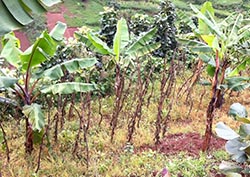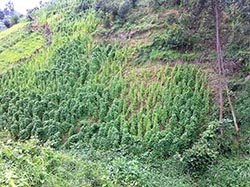A year ago, I was in Uganda to study farmers’ adaptations of improved climbing bean technologies in the Eastern and Southwestern highlands. These improved technologies had been shown to farmers at N2Africa demonstration trials, and they tested the practices of their liking on their own land.
Skipping to one of the main findings: bean yields were not larger on plots where farmers tried some improved practices (e.g. row planting, narrower row spacing, only two seeds per hole) compared to plots with the farmers’ usual practices (e.g. seed broadcasting). When explaining their yields, farmers indicated that any effects of cropping practices must have been overridden by more influential factors, including damage by animals, stake scarcity and soil fertility variability. Clearly, these constraints need to be tackled before the effects of any more detailed cropping practices can be revealed. I am therefore suggesting a few practical measures:
|
Image 1. Damage by rats |
Biocontrol against rats Alternatively, it could be helpful to work together with farmers to test pitfall traps. Pitfall traps have proven to be successful in rodent control in East Africa (Makundi et al., 1999). |
|
Image 2. Plastic bottle cutter |
Plastic waste to replace stakes Scarcity of staking material was another clear constraint for climbing bean production. On several demonstration trials, N2Africa introduced the practice of string staking: beans growing along strings that are supported by a few strong poles. This strongly reduces the number of stakes required, but farmers complain that strings are too expensive. I therefore propose to replace these strings with something that can be found in practically any ditch in villages: plastic waste. Recently a start-up company has released a simple tool to cut long strands from plastic bottles (Image 2). These strands are strong enough for string staking. Just one or a couple of the bottle cutter tools would be enough to provide a lot of free plastic string material. https://plasticbottlecutter.com/ |
|
Image 3. Soil fertility variability (Kanungu Dstrict) |
Soil fertility management Shrubs or trees marking the edges of some fields may be replaced or complemented with leguminous trees such as Leucaena spp. that can be a source of green manure, fuel and fodder, while conserving the soil with deep roots that fix nitrogen. |
More suggestions and findings with regard to farmers’ implementation of improved practices can be found in my internship report.
Eva Thuijsman, MSc student at Wageningen University & Research
References:
- Enriquez, P. A., & Mikkola, H. (1997). Comparative study of general public owl knowledge in Costa Rica, Central America and Malawi, Africa. In Duncan J.R., Johnson, D.H. & Nicholls, T.H. (Eds) Biology and conservation of owls of the Northern Hemisphere, p. 160-166.
- Makundi, R.H., Oguge, N.O. & Mwanjabe PS. (1999). Rodent pest management in East Africa - an ecological approach. In: Singleton, G.R., Hinds, L.A., Leirs, H. & Zhang, Z. (Eds). Ecologically-based management of rodent pests. Canberra, Australia: ACIAR. p 460-76.
- Martin, J. M., Raid, R. N., & Branch, L. C. (2009). Barn owl (Tyto alba).University of Florida, IFAS Extension, 185(1), 1-3.
- Meyrom, K., Motro, Y., Leshem, Y., Aviel, S., Izhaki, I., Argyle, F., & Charter, M. (2009). Nest-box use by the Barn Owl Tyto alba in a biological pest control program in the Beit She’an valley, Israel. Ardea, 97(4), 463-467.
- Ojwang, D. O., & Oguge, N. O. (2003). Testing a biological control program for rodent management in a maize cropping system in Kenya. Aciar Monograph Series, 96, 251-253.



